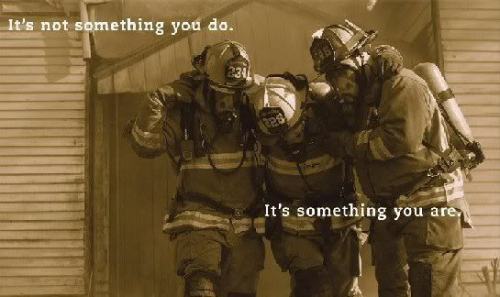A structure fire with reports of people trapped or a multi-car crash on the interstate can be one of the most stressful calls that a firefighter hears. Prior to coming to work at the Virginia Department of Fire Programs, I never thought about firefighters. I figured they were just normal people doing their jobs. So it got me to thinking, what do firefighters do?
Firefighters handle an array of emergency calls. Yes, we’ve all heard about the sweet old lady calling the fire department because her cat was stuck in a tree but that is just tipping the ice berg. Here are just a few of the different types of calls that firefighters respond to: house fires, vehicle accidents, chemical leaks and spills, trapped elevators with people inside, lost children and adults, EMS calls, water rescue missions in the James River, fire alarms and sprinklers malfunctioning, false alarms, and assisting their communities during natural disasters such as earthquakes and floods.
Environment and conditions can greatly affect the response time to an emergency call (Steele, 2007). A 10 year old girl with a broken leg on the playground would be a normal call, but if that same little girl was actually in a remote area such as in the forest, then it limits your access to reach the victim and will involve more equipment and manpower (Steele, 2007). Your team's expertise will come into play, and you will relay on previous training to successful complete the rescue mission (Steele, 2007).
You would think using a helicopter to rescue the little girl would be the best route, but depending how remote the area is the helicopter may not be able to land due to the dense tree line (Steele, 2007). You must always have a plan B or maybe a plan C in your rescue missions (Steele, 2007). Always expect the unexpected; even a routine call will have obstacles. Rely on your training and your fellow members that have more expertise and knowledge.
Using this same scenario and performing plan B because the helicopter is not available, you grab some rigging packs, a stokes basket, and medical supplies and start hiking through the woods on your five mile trek to reach your victim (Steele, 2007). The gear that you have on, the boots and the heavy equipment can really weigh you down. The rigging packs that you hasty pack with so many supplies can easily weigh 40 pounds and all of the medical supplies can weigh close to 80 pounds (Steele, 2007). Well let’s face it, you never know what you will need and you would rather have it and not use it versus need it and not have it.
During this long walk, with all of the heavy gear you will need to carry, you may have more victims than when you started (Steele, 2007). You may have a member complain about feeling chest pains, your main priority will be to save your fellow teammate which means another team will need to respond to the original mission which will delay their call for help (Steele, 2007).
There are all types of training you can take to prepare your team to handle calls in all environments. If your department is located near a forest or park, this scenario would probably be a routine EMS call, your members would practice this drill, and know exactly what equipment to bring along to reduce the weight of supplies (Steele, 2007). The key is to exercise, be in shape to handle the more rigorous calls, and have plan a, b, and c to anticipate the challenges that may occur during each call.
Most departments don't have the time to train most specialty areas that they may need to respond to in the future (Steele, 2007). The key is to plan and research different scenarios that could happen in your area (Steele, 2007). Encourage your members to think outside the normal calls you routinely answer, this will create a more confident and competent firefighter (Steele, 2007).
Firefighters perform a wide range of calls to protect our communities. For example, my friend ran a call where a security guard driven out of boredom, decided to handcuff his hands together, unfortunate for him; he did not have the key to release himself. The next day they went back to the place of business to do a flow up, only to learn the security guard was terminated for his stupidity.
Another friend was working a house fire when he found an unconscious cat. He brought the cat outside, performed CPR by cupping his hands around the cats face, blew into its nose, and saved the homeowner’s precious pet. Due to demand, suppliers have created pet sized oxygen masks for dogs and cats, but they are very expensive. Most departments cannot afford them and must rely on the old fashion method of mouth to snout resuscitation.
The end results of the firefighter calls, for the most part, ends in tragedy. For example, loss of life, loss of personal belongings that can never be replaced, and leaves many people homeless. Thank goodness a lot of calls are also humorous and have a happy outcome.
Steele, L. (2007, February) Rescue without the big red truck. Fire Engineering. Vol 160. Issue 2, p99-108, 7p. Retrieved November 3, 2012, from Academic Search Complete database.




